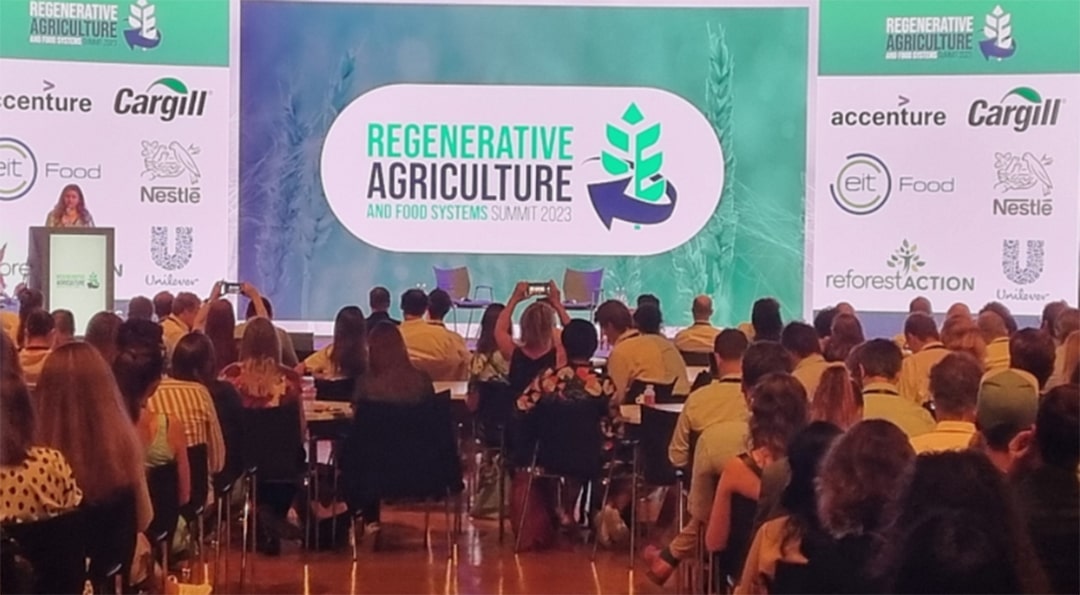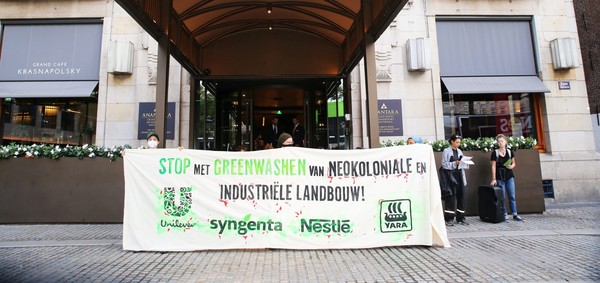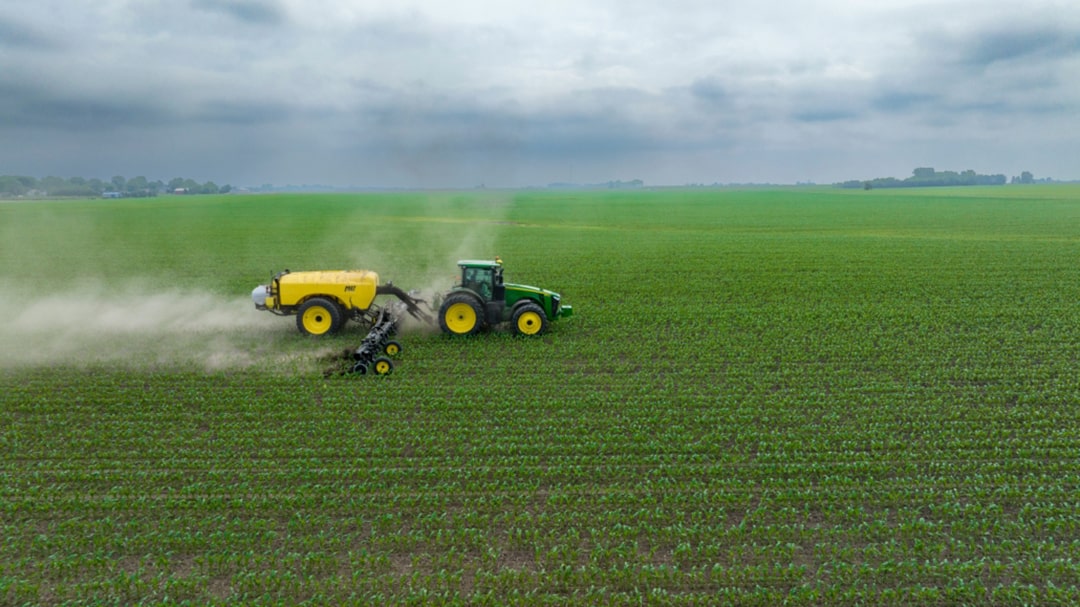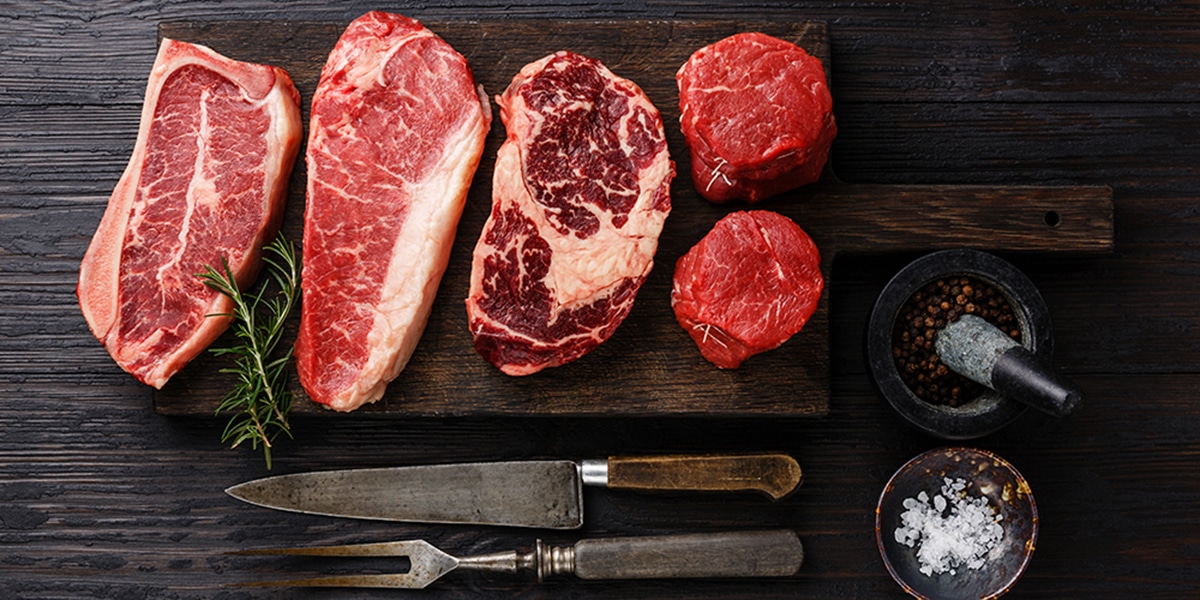

Photo: Regenerative Agriculture and Food Systems Summit 2023 – Amsterdam.
Regenerative agriculture was a good idea, until corporations got hold of it
by GRAIN | Dec 1, 2023
Food and agribusiness giants have coalesced around the term “regenerative agriculture” to signal their commitment to climate change and sustainability. This year’s COP28 will showcase regenerative agriculture prominently, and the term is gaining traction in policy circles, investor conferences and supermarket shelves. But it is just the latest iteration of an on-going corporate strategy to undercut support for agroecology and shore up corporate profits amid multiple crises caused by the model of industrial agriculture they depend on.
The Dutch-Anglo corporation Unilever is one of the world’s largest and oldest food companies. Its sprawling empire was built on a foundation of plantations and industrial farms producing palm oil, soybeans, tea and other crops to feed its factories. Lately Unilever’s come to doubt the sustainability of its agricultural foundations.
“Our food system is not resilient to climate change or the impact of crises due to the results of conventional, harmful farming practices paired with over reliance on too few types of crops,” says its Global Head of Sustainability, Dorothy Shaver. “This is why Unilever has committed to investing in the transition to regenerative agriculture.”
Tomatoes, one of the “too few types of crops” that Unilever is a top buyer of, would be a good place to start this transition. Tomatoes are grown all over the world, but their production for companies like Unilever is heavily industrialised and concentrated in just a few countries, and, in fact, in just a few select regions where there is access to cheap labour, land and water. From these places, tomato products flood global markets, undercutting small farmers and food producers. China’s Xinjiang province, which has come under fire for forced labour of Uyghurs on its farms, is one of the leading producers for foreign food corporations.
Another huge producer is Spain’s Extremadura region, where production is dominated by one company– the Conesa Group. The family-owned company, with a track record of using its monopoly power to pay farmers “ruinous” prices and of illegally pocketing EU farm aid, says that nearly three-quarters of its massive 2,250 ha tomato farm in Badajoz is dedicated to supplying the multinational.
The Badajoz farm is now the showcase for Unilever’s regenerative agriculture strategy, with a focus, in this case, on water. Using what it calls “regenerative agriculture” techniques, Unilever claims that they have been able to reduce water usage on the farm by 35% and increase yields by 30%, mainly by installing drip irrigation and a satellite monitoring system. While these might seem like impressive numbers, they are far from what could really be considered “regenerative” in a context like Extremadura’s.
Extremadura is going through its worst water crisis in history. Part of the reason is drought, which appears now to be a permanent phenomenon of climate change. But the bigger reason is the out of control expansion of irrigated agriculture to produce crops for export. The massive expansion in irrigation in recent years has made Extremadura one of the world’s top producers of water-thirsty crops like tomatoes, but at a huge cost to the environment and other water users. Since 2015, both the area devoted to irrigation and the water used for irrigation have increased significantly, even as many farms have converted to drip irrigation, which now accounts for 60 percent of all irrigation in the area.
“We need to think seriously about reducing the area under irrigation and to opt for crops with lower water requirements,” says Eugenio Romero, an agricultural researcher in Extremadura. He says that the region can no longer afford to export water via crops like tomatoes. “The math doesn’t add up. There is not enough water for everything. The crop map of Extremadura is no longer sustainable.”
The problem, then, is not how the Badajoz farm and others like it produce their tomatoes; it’s that they produce tomatoes at all. Changing Extremadura’s crop map in a way that truly regenerates water would involve a shift to a diverse set of foods for local markets, and this would require small farms and dynamic rural communities– not mega farms and transnational food corporations. In the case of Extremadura, which has among the most unequal and concentrated land ownership in Europe, it would mean changing the land map too.
Such transformations are far outside the scope of Unilever and Conesa’s regenerative agriculture plans. What they are proposing is a way to avoid such changes and keep the taps open a little longer for a dying industry. Meanwhile both companies are hedging their bets and expanding production in Xinjiang, where the water situation is not yet as critical.
Yesterday’s “degenerative” is today’s “regenerative”
Unilever’s not alone in its promotion of “regenerative agriculture”. It’s become a new buzzword for practically all of the world’s largest food and agribusiness companies, as well as clothing manufacturers, most of them having made commitments over the past few years. But what these corporates mean by “regenerative agriculture” is a far cry from what the pioneers of the concept intended. The term was coined in the 1980s by farmers dismayed with the industrial food system in the US. They began articulating a vision for agriculture that was about “bringing farmers and consumers back into contact with one another, better mental health for farmers, the resilience of rural economies, the role of small-scale producers, processers and distributers, and a redistribution of power in the food system.”
These early social and political goals are entirely absent in today’s corporate “regenerative agriculture” projects. Their focus is instead on tweaking the practices of their farmer suppliers to make some improvements when it comes to soil health, water use, greenhouse gas emissions and biodiversity. All of these “improvements” have to be measurable so that the food companies can market their products as “regenerative”.

Action in protest of ‘regenerative agriculture’ conference in the Netherlands, Sept. 2023. Photo via ASEED
In 2023, the Sustainable Agriculture Initiative (SAI) Platform, which brings together most of the world’s largest food and agribusiness corporations, released its global framework for regenerative agriculture. It lists nine “outcomes” for assessing whether a farm is regenerative, all of them focussed on increasing carbon in the soils, improving water management, decreasing emissions and protecting biodiversity. SAI decided not to include “livelihood and social elements” because these were too “complex and challenging” to measure.
“The basic principle is to do more with less, in other words, greater productivity with less use of inputs, less use of water, less greenhouse gas emissions, less risk of soil degradation and less use of fuels and energy,” says Luciano Souza a director with global grain trading giant Archer Daniels Midland (ADM), one of the companies that is part of SAI. ADM is pursuing a regenerative agriculture project with the multinational pesticide and seed giant Bayer and large-scale soybean farmers in the biodiverse Cerrado region of Brazil, an area that has been devastated by two decades of industrial agriculture expansion. So, too, is the US-based grain trader, Bunge, but with India’s leading seed, fertiliser and pesticide company, UPL (formerly United Phosphorus Limited).
It may seem counter-intuitive for agrochemical companies like Bayer and UPL to be involved in regenerative agriculture projects that aim to use less inputs. But corporate regenerative agriculture is about efficiency, which can translate into increased sales for them. For example, most corporate regenerative agriculture schemes encourage the use of herbicides for weed control as a way to increase carbon in soils by avoiding ploughing or to reduce methane emissions by direct-seeding rice. They also encourage farmers to purchase more precise and more expensive types of fertilisers or new biological versions of pesticides. And, perhaps most importantly, they can lock farmers into their digital platforms, where they can influence farmer decisions.
To participate in Bunge and UPL’s regenerative agriculture programme, famers in Brazil have to sign up to the companies’ digital platform, Origeo. The platform not only tracks and measures their regenerative “outcomes”, but also advises them on what practices to adopt and what seeds and chemical inputs to use. Ultimately, Origeo will channel the sale of their harvests through Bunge to food companies that want to market their products as regenerative.
Regenerative agriculture also allows agribusiness to tap into the rapidly growing world of “green finance”. The Brazilian agribusiness giant Amaggi, for example, issued a US$750 million green bond on international markets in 2021 to finance the transition to regenerative agriculture on its massive farms. Unilever, meanwhile, has created its own private equity fund to invest in regenerative agriculture, one of several newly established regenerative agriculture private equity funds, while Nestlé is testing out business models for private and public finance on a German government funded regenerative agriculture project stretching over 3 million hectares in Argentina, Colombia, Ecuador, Paraguay and Peru.
Farmers, meanwhile, should not expect corporations to cover the added costs that they might have for implementing corporate regenerative agriculture programmes. There’s been much talk, but none of the big food and agribusiness companies have put any significant money of their own on the table when it comes to compensating farmers for the implementation of regenerative practices, whether through direct payments or premiums for their crops. If these projects move forward in a significant way, the costs will be born by farmers and the public.
“At the moment, the risks of the transition are way too much on the shoulders of the farmers,” admits Stefania Avanzini, the Director of One Planet Business for Biodiversity, which is the main promoter of regenerative agriculture within the global corporate lobby group, the World Business Council for Sustainable Development (WBCSD). “We need the financial sector to step up to de-risk the farmer transition and also, let’s be honest, reduce the cost of bringing the public sector to finance it.”
Why not agroecology?
The pioneers of regenerative agriculture are understandably furious about this corporate co-optation of the term. Regenerative agriculture farming groups in Spain and Italy have launched campaigns to denounce Bayer for using the term to promote its Roundup herbicide. Spanish groups have even taken out a trademark on “agricultura regenerativa” to try and protect it against greenwashing.
But they are fighting an uphill battle. There’s a huge, well-funded lobby working to align governments and other actors behind the corporate regenerative agriculture agenda. At this year’s COP28 in Dubai, through an initiative called Regen10, they are launching a plan focusing on regenerative landscapes that the WBCSD is leading, with the help of high profile consultancy firms. Regen10’s stated focus is on “conventional agriculture” and corporate supply chains, for which it aims to “deliver a universal measurement framework”. Its sales pitch is that solutions to the overwhelming crisis can be found within the dominant industrial food system and, in particular, at the level of the farm. They see no need to consider larger questions about what food should be produced, how that food should be distributed or how precious resources like land, water and seeds should be shared and managed in the context of a boiling planet.
What does all this high-level hype mean for action on the ground? This year, a FAIRR study of corporate commitments to regenerative agriculture found that very few translated into real actions. Not even the most basic things like setting quantifiable targets, testing pilot programmes or putting in place certification systems were addressed.
It is important to remember that a decade ago, the same companies were clambering for “climate-smart agriculture” at United Nations’ conferences. When that rather meaningless concept fell out of favour and their voluntary pledges evaporated, they turned to “nature-based solutions“– an equally ambiguous term that was also pushed heavily in the UN for a short while. Both of these concepts were seized on by food and agribusiness corporations as a way to distract everyone from real solutions, and, in particular, agroecology. It is quite possible that these companies will soon walk away from “regenerative agriculture” and find another buzzword once their greenwashing kills off the positive connotations it owes to farmer-led initiatives.
It’s probably no coincidence that corporations decided to embrace regenerative agriculture in 2019, the year that all 197 member countries of the UN’s Food and Agriculture Organisation endorsed a set of “10 elements of agroecology”. “Agroecology” is a well-defined concept, anchored in peasant and Indigenous movements, and backed by a huge base of scientific literature. It cannot be so easily isolated from its social and political dimensions and remoulded to fit into corporate supply chains, especially when it is understood to be framed by another, equally important concept, “food sovereignty”. These two concepts terrify corporations because they offer real solutions that challenge corporate power and that call for food systems organised according to the needs of food producers and consumers not the profits of corporations.




